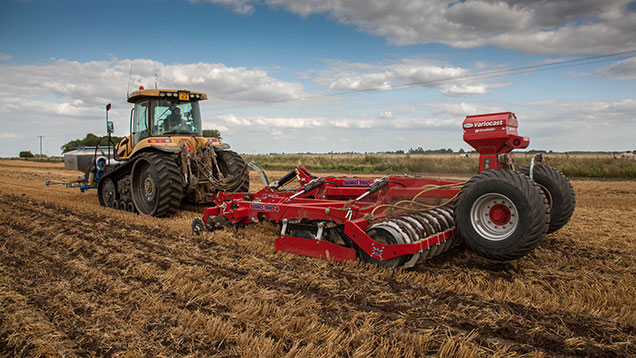Cereals 2015: Better yields from herbicide-tolerant OSR

New Clearfield oilseed rape varieties were unveiled at Cereals, bringing more choice and introducing additional traits to the specialist production system.
Both Dekalb and DuPont Pioneer were displaying their latest hybrid varieties at the event, ahead of the first seed sales for planting this autumn.
Read more news, photos, video and information from Cereals 2015
But neither of the two new varieties are included or described on the Recommended List, so growers are reliant on being able to interpret the breeder’s trials for their yield and agronomic data.
See also: Herbicide-tolerant OSR beats weeds
However, both companies were claiming improvements in gross output and disease resistance, stressing the progress that has been made in Clearfield variety development and the potential for the system in the current economic climate.
Niche crop
To date, Clearfield oilseed rape accounts for just 4% of the total oilseed rape area in the UK, so is often considered as a niche opportunity rather than the flexible management tool that it can be, points out Deryn Gilbey of Dekalb.
“Our research shows it is mainly being grown where cruciferous weeds, especially charlock, have become such a problem that parts of the farm are no-go zones as far as oilseed rape is concerned,” he says.
“But it also has other benefits beyond weed control – including the stretching of rotations, the easing of workloads and the use of land previously considered not suitable for the crop.”
Grower feedback has shown there were challenges with the early Clearfield varieties, he admits. “They identified that yield potential needed to be increased and they wanted normal-height varieties, not just semi-dwarves.
“They also wanted to see the Clearfield trait introduced into Holl [high-oleic, low-linolenic] varieties, to make it easier to achieve the specification. That is something we are still working on.”
This autumn
Looking forward to this autumn, Mr Gilbey emphasises the ability of Clearfield varieties to eliminate the need for pre-emergence herbicides.
“There is no need to spend on the crop until you know it has escaped flea beetle attack and is well-established,” he points out. “Just one post-emergence application of Cleranda will deal with charlock, runch, mustards and volunteer rape, as well as many grassweeds.
“You can forget about adding in a graminicide and application can take place up until the weed is at four leaves, so timing is flexible.”
DK Imperial CL is a new normal-height hybrid which has both the pod shatter trait and the double phoma resistance that can be found in other Dekalb varieties, says his colleague Kuldip Mudhar.
“Compared with DK Imagine CL, the first of our Clearfield varieties, it has taken these types to a new level,” he says. “As well as an 8 rating for phoma and a 6 for light leaf spot, it has yields to rival conventional oilseed rape and the pod shatter resistance that will help to prevent volunteers in the following crop.”
Vigorous establishment and autumn growth are other characteristics of the new variety. “It is also suitable for early drilling as it is slower to come out of the winter.”
DuPont Pioneer’s new Clearfield hybrid, PT240CL, is also of normal height and joins the company’s main Clearfield variety PT229CL on the market. Andy Stainthorpe believes both will appeal to growers struggling with weed control issues, but points to PT240CL’s better phoma resistance rating of 7.
“Certainly, more people are trying the Clearfield concept now,” he reports. “There has been a significant increase in their gross output and growers are seeing the value of traits that weren’t in them before.”
Growers with three years’ experience of Clearfield aren’t reporting difficulties with volunteers, he says. “In practice, their fears about volunteers haven’t materialised.”
What is Clearfield?
The Clearfield production system consists of two elements – herbicide-tolerant hybrid oilseed rape varieties and BASF’s broad-spectrum herbicide Cleranda (metazachlor + imazamox).
The use of traditional plant breeding techniques has introduced tolerance to the imadazoline herbicides into Clearfield oilseed rape, allowing ALS inhibitor chemistry to be applied to a crop without harm.
Used together, they facilitate a different approach to weed control by making best use of post-emergence broad-spectrum activity and allowing a “one-shot” herbicide strategy.
Established cruciferous weeds, which can be very difficult to control in conventional oilseed rape, can be taken out with Cleranda.
Growers choosing to plant Clearfield varieties must follow stewardship advice to prevent the build-up of volunteers in following crops, stress the companies, as their in-built herbicide tolerance means ALS inhibitor herbicides, or sulfonylureas, can’t be relied on to control them.

